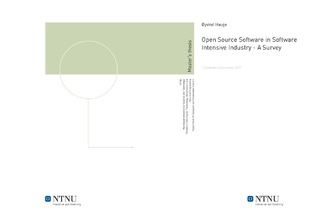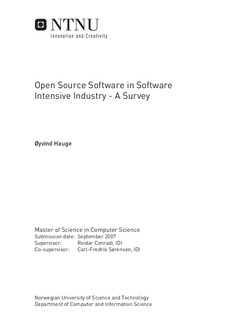| dc.contributor.advisor | Conradi, Reidar | nb_NO |
| dc.contributor.advisor | Sørensen, Carl-Fredrik | nb_NO |
| dc.contributor.author | Hauge, Øyvind | nb_NO |
| dc.date.accessioned | 2014-12-19T13:33:43Z | |
| dc.date.available | 2014-12-19T13:33:43Z | |
| dc.date.created | 2010-09-04 | nb_NO |
| dc.date.issued | 2007 | nb_NO |
| dc.identifier | 348574 | nb_NO |
| dc.identifier | ntnudaim:3290 | nb_NO |
| dc.identifier.uri | http://hdl.handle.net/11250/251241 | |
| dc.description.abstract | The use of Open Source Software (OSS) has increased in both the industry and the public sector. The software intensive industry integrates OSS into their products, participates in the development of OSS products, and develops its own OSS products. The understanding of how and why the industry is approaching OSS is so far limited. To help fill this gap, this thesis intends to explore how and why the software intensive industry approaches OSS. This is done by performing an extensive literature study and by executing a web-based survey. This survey is distributed to a near representative sample of companies from the Norwegian software intensive industry and to a convenience sample of participants in the ITEA 2 research program. The research presented here shows that OSS components are widely used in the software intensive industry. Close to 50% of the Norwegian software intensive industry uses OSS in its development. The industry is mainly motivated to use OSS by practical reasons. OSS components provide functionality of high quality and the industry is satisfied with its use of these components. When using OSS, the industry benefits from the availability of source code, and easy access to components and information about these components. Companies participate in OSS projects because they use the software and because of the learning effect of this participation. The participation is however limited. However, some companies provide commercial services related to the OSS projects they participate in. Releasing a product as OSS attracts more users and customers to a product. These community members may contribute with implemented code, feedback, and requirements. There are, however some side-effects related to releasing an OSS product and companies should be aware of these consequences. The main contributions of this thesis are new understanding of how and why companies approach OSS, a reusable research design, and experiences performing survey research. | nb_NO |
| dc.language | eng | nb_NO |
| dc.publisher | Institutt for datateknikk og informasjonsvitenskap | nb_NO |
| dc.subject | ntnudaim | no_NO |
| dc.subject | SIF2 datateknikk | no_NO |
| dc.subject | Program- og informasjonssystemer | no_NO |
| dc.title | Open Source Software in Software Intensive Industry - A Survey | nb_NO |
| dc.type | Master thesis | nb_NO |
| dc.source.pagenumber | 241 | nb_NO |
| dc.contributor.department | Norges teknisk-naturvitenskapelige universitet, Fakultet for informasjonsteknologi, matematikk og elektroteknikk, Institutt for datateknikk og informasjonsvitenskap | nb_NO |

